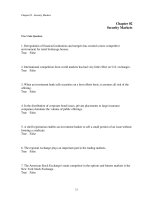Practice investment management pim3 ch09
Bạn đang xem bản rút gọn của tài liệu. Xem và tải ngay bản đầy đủ của tài liệu tại đây (1.76 MB, 38 trang )
CHAPTER NINE
TECHNICAL ANALYSIS
Practical Investment Management
Robert A. Strong
Outline
Charting
The Underlying Logic
Types of Charts
Other Chart Annotations
Technical Indicators
Indicators with Economic Justification
Indicators of the Witchcraft Variety
South-Western / Thomson Learning © 2004
9-2
Outline
Old Puzzles and New Developments
Fibonacci Numbers
Dow Theory
Kondratev Wave Theory
Chaos Theory
Neural Networks
The Future of Technical Analysis
South-Western / Thomson Learning © 2004
9-3
Charting: The Underlying Logic
The technical analyst believes
that charts can be used to
predict changes in supply and
demand and investor behavior.
Market participants seldom wait
for things to completely unfold.
They try to anticipate events
rather than merely react to them.
South-Western / Thomson Learning © 2004
9-4
Charting: Types of Charts
The technical analyst uses many types of
charts:
line charts
bar charts
point and figure charts
candlestick charts
South-Western / Thomson Learning © 2004
9-5
Linear Scale Line Chart
Insert Figure 9-1 here.
South-Western / Thomson Learning © 2004
9-6
Logarithmic Y-Axis Line Chart
Insert Figure 9-2 here.
South-Western / Thomson Learning © 2004
9-7
Bar Chart
Insert Figure 9-3 here.
South-Western / Thomson Learning © 2004
9-8
Point and Figure Chart
Insert Figure 9-4 here.
South-Western / Thomson Learning © 2004
9-9
Candlestick Chart
South-Western / Thomson Learning © 2004
9 - 10
Charting: Other Chart Annotations
Chartists believe investors remember missed
opportunities and look for them to return.
support level
resistance level
congestion area
breakout
South-Western / Thomson Learning © 2004
9 - 11
Charting: Other Chart Annotations
Insert Figure 9-6 here.
South-Western / Thomson Learning © 2004
9 - 12
Technical Indicators
These statistics, either calculated or directly
observed, are alleged to have a relationship
with the future direction of the overall stock
market or with an individual security.
Indicators with economic justification are
based on economic activities that are
measurable and observable.
Indicators of the witchcraft variety have no
logical connections between the
measurements and what the
measurements purport to show.
South-Western / Thomson Learning © 2004
9 - 13
Indicators with Economic Justification
The higher the short interest figure, the
larger is the potential demand for the
shares.
South-Western / Thomson Learning © 2004
9 - 14
Short Interest
Insert Table 9-1 here.
South-Western / Thomson Learning © 2004
9 - 15
Indicators with Economic Justification
Increased margin buying has historically
been associated with rising markets.
South-Western / Thomson Learning © 2004
9 - 16
Margin Loans
South-Western / Thomson Learning © 2004
9 - 17
Indicators with Economic Justification
Cash held by mutual funds represents
potential demand for stock.
South-Western / Thomson Learning © 2004
9 - 18
Mutual Fund Cash Position
Insert Figure 9-8 (Mutual Fund
Cash Position Rule) here.
South-Western / Thomson Learning © 2004
9 - 19
Mutual Fund Cash Position
South-Western / Thomson Learning © 2004
9 - 20
Indicators with Economic Justification
When the confidence index gets closer to
1.0, investors are more likely to be bullish
about the economy, and therefore about
corporate earnings.
South-Western / Thomson Learning © 2004
9 - 21
Confidence Index
Insert Figure 9-10 here.
South-Western / Thomson Learning © 2004
9 - 22
Indicators with Economic Justification
An advance-decline line is a graphical
representation of the net advances over a
period of time.
South-Western / Thomson Learning © 2004
9 - 23
Advance-Decline Line
Insert Figure 9-11 (Market Breadth)
here.
South-Western / Thomson Learning © 2004
9 - 24
Indicators with Economic Justification
A high relative strength ratio, such as a
high relative PE, means that investors are
willing to pay more for the past earnings of
a company than average.
South-Western / Thomson Learning © 2004
9 - 25









